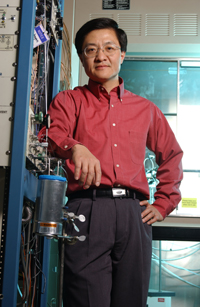Educators have known for years about the benefits of using cooperative, hands-on, active or problem-based learning approaches. But in college, especially in engineering and the sciences, lecturing remains the most common teaching format.
With a Fulbright Scholar grant, Professor Bernard Van Wie bucked that trend, having spent the 2007-2008 academic year teaching students using a unique, one cubic-foot Desktop Learning Module (DLM) at Ahmadu Bello University in Nigeria. The DLMs make it easy for educators to use the more modern and better pedagogical approaches that include Cooperative, Hands-on, Active and Problem-based learning – in short Van Wie’s group calls this approach CHAPL.
In addition to lecturing and conducting research in developing biosensors for measuring toxic compounds in common Nigerian food products made from cassava , Van Wie employed the DLM and CHAPL pedagogy he is developing under a National Science Foundation grant to improve engineering education. The DLMs accept plug in cartridges useful for learning principles in chemical, mechanical, civil and bioengineering.
Now with an additional $2.9 million grant from the World Bank, Van Wie, his Washington State University team and fellow researchers from Nigeria will produce roughly 400 desktop learning modules for use throughout Nigeria. Seven other research institutions in the U.S. are also collaborating on the project so the group will be able to contrast and compare how the approach benefits learning in a developing nation versus that in a well developed country.
Van Wie’s research proposal rated No. 1 in Nigeria for the World Bank competition and he will begin Phase I of the funding this year with an initial sum of $500,000. The researchers expect to receive the remaining $2.4 million upon reaching pre-set benchmark goals.
“I really believe in implementing modern teaching pedagogies into the engineering classroom as it helps students understand the material far better than they would from a traditional lecture format,” said Van Wie. “We want to be able to supply this equipment in an easy-to-use and affordable format.”
The DLM, originally developed with the assistance of Paul Golter, the Chemical Engineering Instructional Supervisor, and Gary Held, an engineering technician with the College of Engineering and Architecture shops, will be reformatted for mass production by Infinetix Corp. in Spokane and will be assembled in Kaduna, Nigeria by Major Academy Ltd. for use in classrooms in all six of Nigeria’s geopolitical regions. Of major importance is that experienced educational researchers are involved in assessing the impact that the DLM and CHAPL have on learning progress. Key players are Gary Brown, Director of the Washington State University Center for Teaching, Learning and Technology, and Ray Bako, a Senior Lecturer from Ahmadu Bello University.
Van Wie’s desktop modules allow students to match the math they are learning with what is actually happening physically. For instance, to understand the concept of heat transfer they will have in front of them a small working heat exchanger with temperature indicators at different spots. Equations explaining heat transfer concepts are written by the students on a nearby tablet of paper. Students can plug numbers into the equation for the surface area, liquid temperatures, and heat transfer coefficients, but these numbers can only be determined by close inspection and analysis of the physical system in front of them. Instead of memorizing the equation, the students are learning the physical and phenomenological meaning behind the terms that make up the equation.
Furthermore, because this hands-on apparatus also contains valves and flow measuring equipment, running conditions can be changed and observed, and temperature changes can be compared with what the equations predict.
“The DLM is interesting in that it provides a compact, modular system for the demonstration of basic principles of heat transfer, fluid mechanics, etc. and new experiments can be created and added easily,” said Infinetix CEO and President Bruce Weyrauch. “It is also interesting that the system uses a simple fluid system that doesn’t need pressurized liquid, or a lot of electrical power.”
To ensure a smooth transition from assembly to teaching, lecturers and PhD graduate students from eight Nigerian collaborator universities will be invited to a U.S. workshop in May 2009 where Van Wie will present teaching pedagogy, DLM technology, and pedagogical assessment approaches for DLM use.
By developing the DLMs, Van Wie and his research associates hope that faculty will be more willing to use the new types of cooperative, hands-on, active, problem-based pedagogy and that students will learn both the core course concepts as well as ‘soft skills’ like the team work and communication skills that are a necessary part of an engineering career.
“In a perfect world, we’d hope to create a new paradigm for learning that will become integrated worldwide, allow students to learn better and allow professors to adapt the best teaching practices out there,” said Van Wie, who ended with a quote from Kirk Humphries: “Telling is not teaching, listening is not learning – you learn to do by doing.”
Van Wie is one of approximately 800 U.S. faculty and professionals who traveled abroad this past year through the Fulbright Scholar Program. Established in 1946 under legislation introduced by the late Senator, J. William Fulbright of Arkansas, the program’s purpose is to build mutual understanding between the people of the United States and the rest of the world.
The Fulbright Program is sponsored by the U.S. Department of State, Bureau of Educational and Cultural Affairs. Since its inception, the program has exchanged approximately 273,500 people – 102,900 Americans who have studied, taught, or research abroad and 170,600 students, scholars and teachers from other countries who have engaged in similar activities in the United States. The program operates in over 150 countries worldwide.


